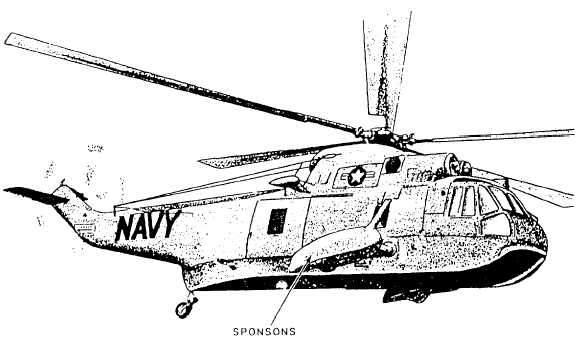Figure 1-16.—H-3 helicopter.
gear to the catapult shuttle and for holdback. In
comparison with the bridle and holdback pendant
method of catapult hookup for launching, the nose gear
launch equipment requires fewer personnel, the hookup
is accomplished more safely, and time is saved in
positioning an aircraft for launch.
ROTARY-WING AIRCRAFT
Learning Objective: Recognize the con-
struction features of the rotary-wing aircraft
(helicopter) and identify the fundamental
differences as compared to fixed-wing aircraft.
The history of rotary-wing development embraces
500-year-old efforts to produce a workable direct-
lift-type flying machine. Aircraft designers’ early
experiments in the helicopter field were fruitless. It is
only within the last 30 years that encouraging progress
has been made. It is within the past 20 years that
production line helicopters have become a reality.
Today, helicopters are found throughout the world.
They perform countless tasks especially suited to their
unique capabilities. Helicopters are the modem-day
version of the dream envisioned centuries ago by
Leonardo da Vinci.
Early in the development of rotary-wing aircraft, a
need arose for a new word to designate this direct-lift
flying device. A resourceful Frenchman chose the two
words-heliko, which means screw or spiral, and pteron,
which means wing. The word helicopter is the
combination of these two words.
A helicopter employs one or more power-driven
horizontal airscrews, or rotors, from which it derives lift
and propulsion. If a single rotor is used, it is necessary
to employ a means to counteract torque. If more than
one rotor is used, torque is eliminated by turning the
rotors in opposite directions.
The fundamental advantage the helicopter has over
conventional aircraft is that lift and control are
independent of forward speed. A helicopter can fly
forward, backward, or sideways, or it can remain in
stationary flight (hover) above the ground. No runway
is required for a helicopter to take off or land. The roof
of an office building is an adequate landing area. The
helicopter is considered a safe aircraft because the
takeoff and landing speed is zero.
The construction of helicopters
construction of fixed-wing aircraft.
FUSELAGE
is similar to the
Like the fuselage in fixed-wing aircraft, helicopter
fuselages may be welded truss or some form of
monocoque construction. Many Navy helicopters are of
the monocoque design.
1-16

